Reflective Learning Approach to Feedback and Assessment Improvement
VerifiedAdded on 2023/06/17
|8
|1995
|164
Essay
AI Summary
This essay defines reflective learning as a process of learning through experiences and self-analysis, emphasizing its role in enhancing critical thinking and improving future actions. It discusses how reflective learning can turn surface learning into deep learning, offering opportunities for self-development and clarifying potential goals. The essay also explores Gibbs' reflective cycle and highlights the importance of feedback and feedforward in student learning. Effective feedback is crucial for setting learning goals and making improvements, while feedforward focuses on future behavior and development. The combination of both enhances students' confidence and performance, especially in formative and summative assessments. Formative feedback, in particular, encourages student reflection and supports continuous improvement.
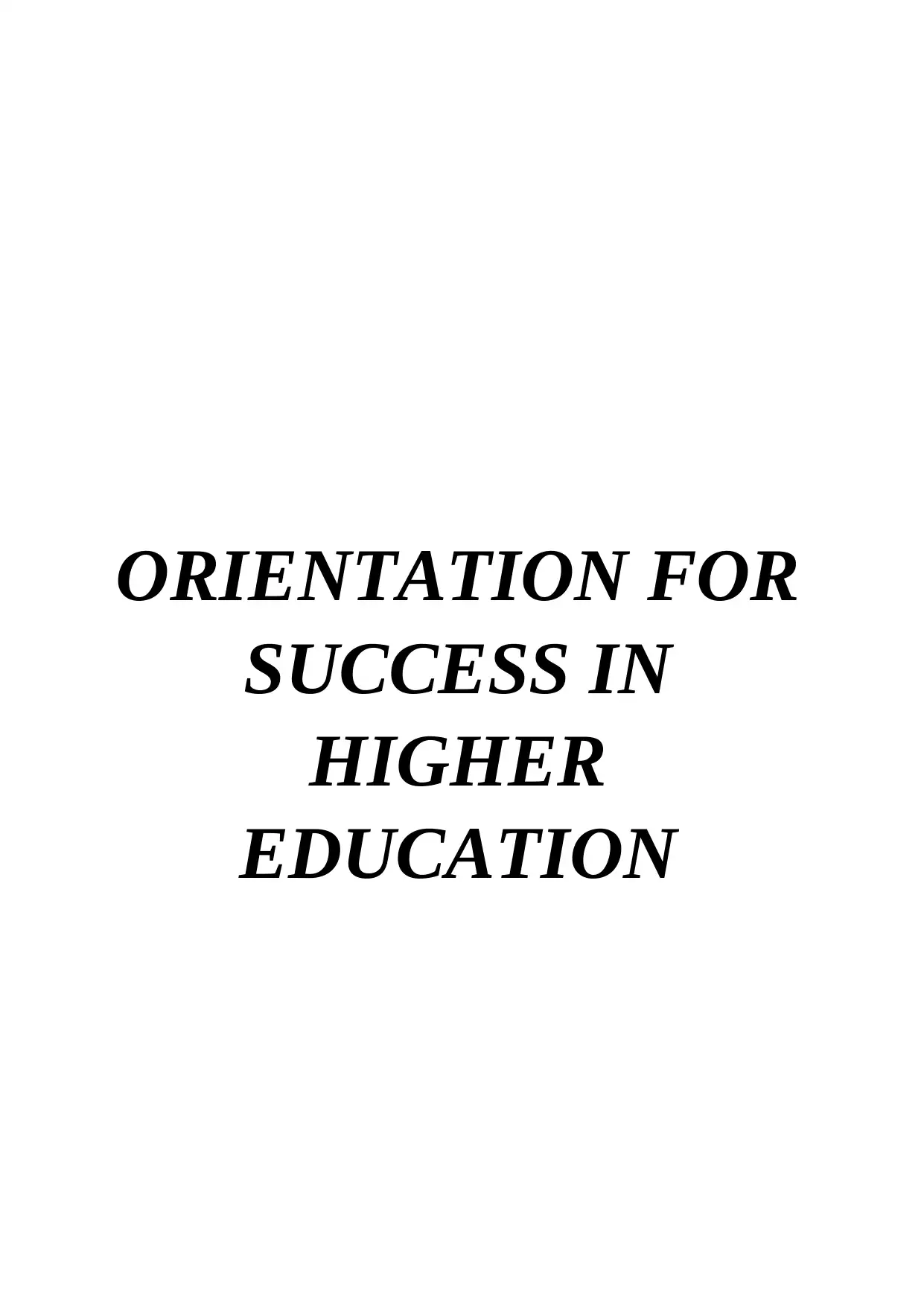
ORIENTATION FOR
SUCCESS IN
HIGHER
EDUCATION
SUCCESS IN
HIGHER
EDUCATION
Paraphrase This Document
Need a fresh take? Get an instant paraphrase of this document with our AI Paraphraser
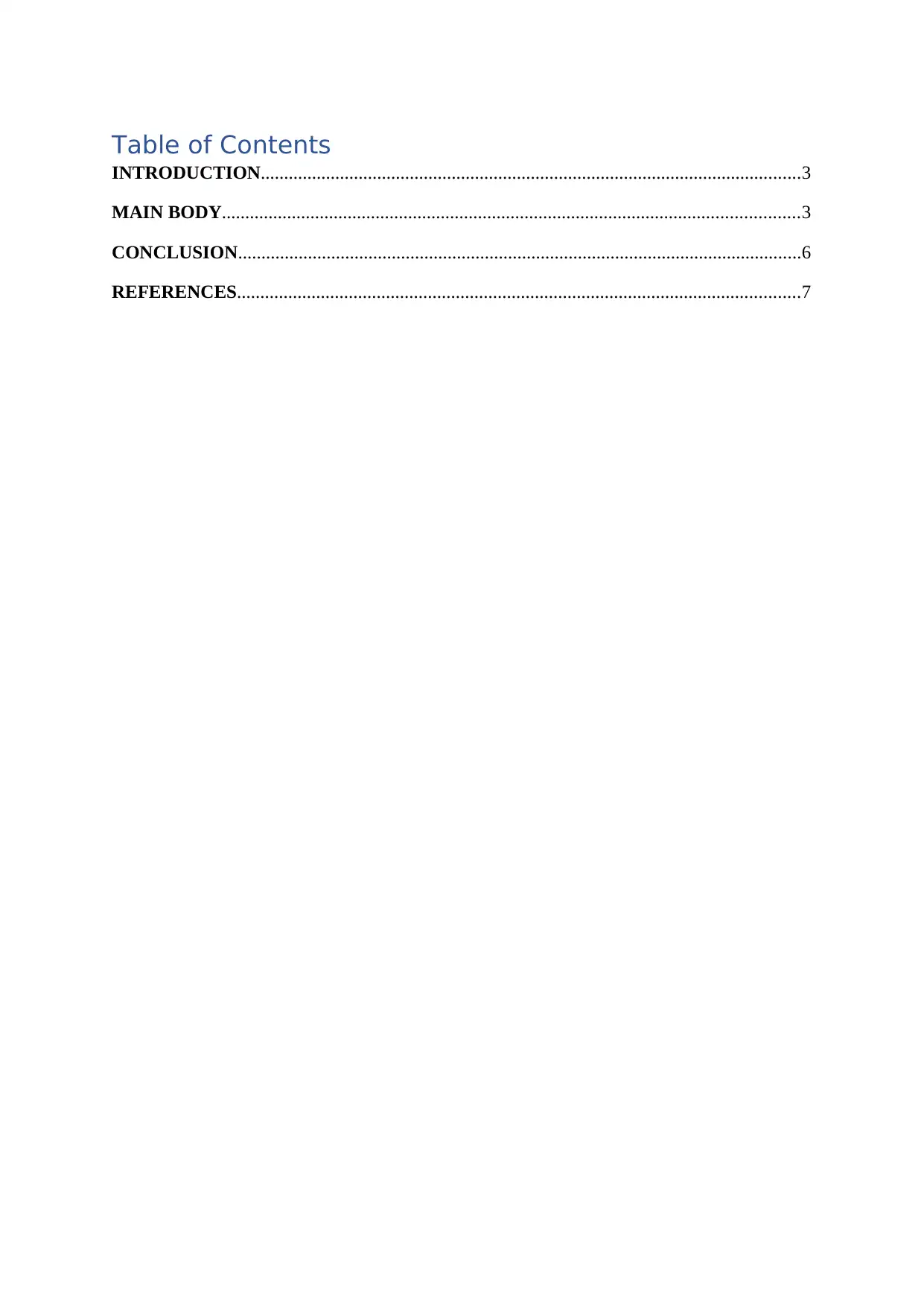
Table of Contents
INTRODUCTION....................................................................................................................3
MAIN BODY............................................................................................................................3
CONCLUSION.........................................................................................................................6
REFERENCES.........................................................................................................................7
INTRODUCTION....................................................................................................................3
MAIN BODY............................................................................................................................3
CONCLUSION.........................................................................................................................6
REFERENCES.........................................................................................................................7
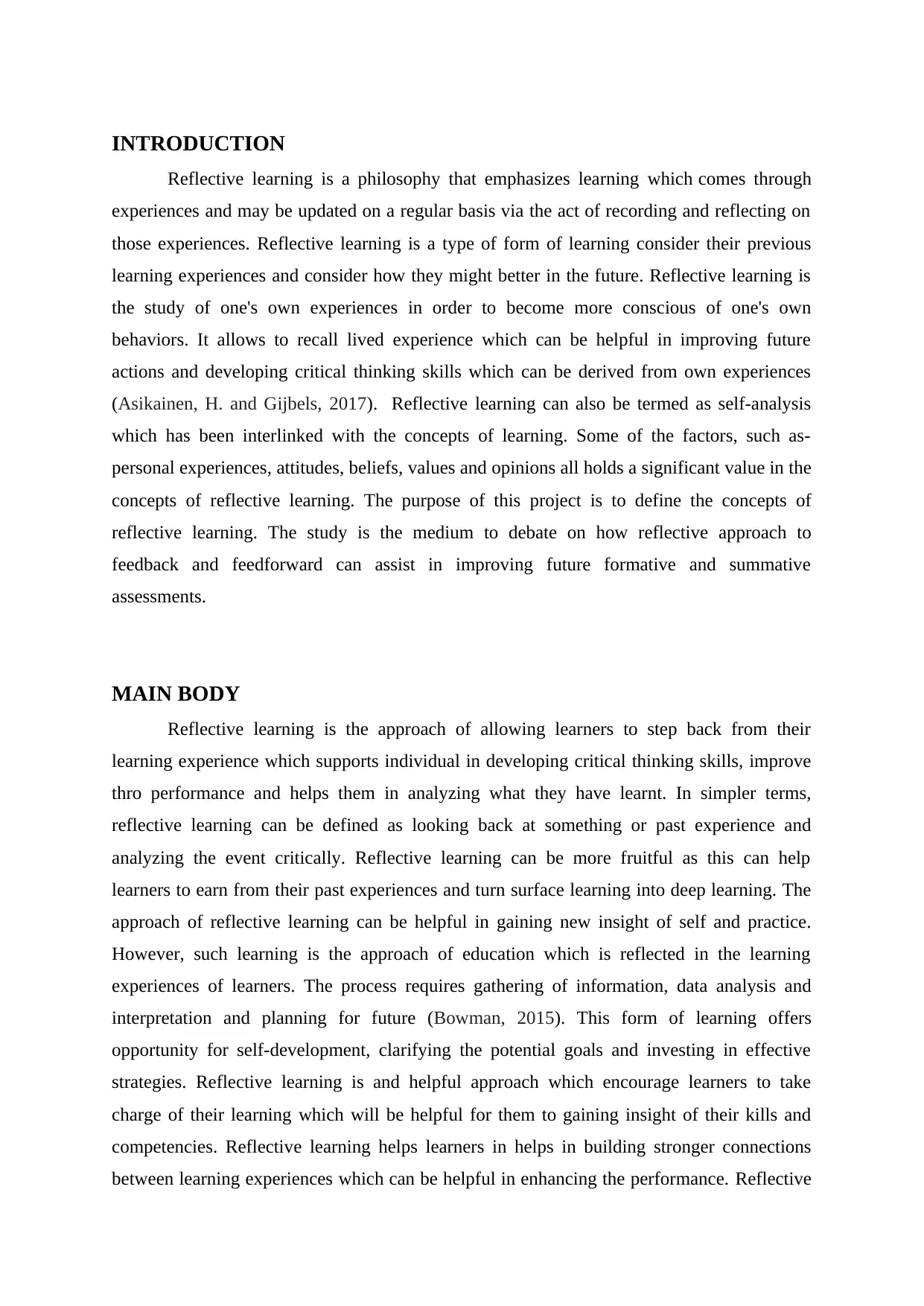
INTRODUCTION
Reflective learning is a philosophy that emphasizes learning which comes through
experiences and may be updated on a regular basis via the act of recording and reflecting on
those experiences. Reflective learning is a type of form of learning consider their previous
learning experiences and consider how they might better in the future. Reflective learning is
the study of one's own experiences in order to become more conscious of one's own
behaviors. It allows to recall lived experience which can be helpful in improving future
actions and developing critical thinking skills which can be derived from own experiences
(Asikainen, H. and Gijbels, 2017). Reflective learning can also be termed as self-analysis
which has been interlinked with the concepts of learning. Some of the factors, such as-
personal experiences, attitudes, beliefs, values and opinions all holds a significant value in the
concepts of reflective learning. The purpose of this project is to define the concepts of
reflective learning. The study is the medium to debate on how reflective approach to
feedback and feedforward can assist in improving future formative and summative
assessments.
MAIN BODY
Reflective learning is the approach of allowing learners to step back from their
learning experience which supports individual in developing critical thinking skills, improve
thro performance and helps them in analyzing what they have learnt. In simpler terms,
reflective learning can be defined as looking back at something or past experience and
analyzing the event critically. Reflective learning can be more fruitful as this can help
learners to earn from their past experiences and turn surface learning into deep learning. The
approach of reflective learning can be helpful in gaining new insight of self and practice.
However, such learning is the approach of education which is reflected in the learning
experiences of learners. The process requires gathering of information, data analysis and
interpretation and planning for future (Bowman, 2015). This form of learning offers
opportunity for self-development, clarifying the potential goals and investing in effective
strategies. Reflective learning is and helpful approach which encourage learners to take
charge of their learning which will be helpful for them to gaining insight of their kills and
competencies. Reflective learning helps learners in helps in building stronger connections
between learning experiences which can be helpful in enhancing the performance. Reflective
Reflective learning is a philosophy that emphasizes learning which comes through
experiences and may be updated on a regular basis via the act of recording and reflecting on
those experiences. Reflective learning is a type of form of learning consider their previous
learning experiences and consider how they might better in the future. Reflective learning is
the study of one's own experiences in order to become more conscious of one's own
behaviors. It allows to recall lived experience which can be helpful in improving future
actions and developing critical thinking skills which can be derived from own experiences
(Asikainen, H. and Gijbels, 2017). Reflective learning can also be termed as self-analysis
which has been interlinked with the concepts of learning. Some of the factors, such as-
personal experiences, attitudes, beliefs, values and opinions all holds a significant value in the
concepts of reflective learning. The purpose of this project is to define the concepts of
reflective learning. The study is the medium to debate on how reflective approach to
feedback and feedforward can assist in improving future formative and summative
assessments.
MAIN BODY
Reflective learning is the approach of allowing learners to step back from their
learning experience which supports individual in developing critical thinking skills, improve
thro performance and helps them in analyzing what they have learnt. In simpler terms,
reflective learning can be defined as looking back at something or past experience and
analyzing the event critically. Reflective learning can be more fruitful as this can help
learners to earn from their past experiences and turn surface learning into deep learning. The
approach of reflective learning can be helpful in gaining new insight of self and practice.
However, such learning is the approach of education which is reflected in the learning
experiences of learners. The process requires gathering of information, data analysis and
interpretation and planning for future (Bowman, 2015). This form of learning offers
opportunity for self-development, clarifying the potential goals and investing in effective
strategies. Reflective learning is and helpful approach which encourage learners to take
charge of their learning which will be helpful for them to gaining insight of their kills and
competencies. Reflective learning helps learners in helps in building stronger connections
between learning experiences which can be helpful in enhancing the performance. Reflective
⊘ This is a preview!⊘
Do you want full access?
Subscribe today to unlock all pages.

Trusted by 1+ million students worldwide
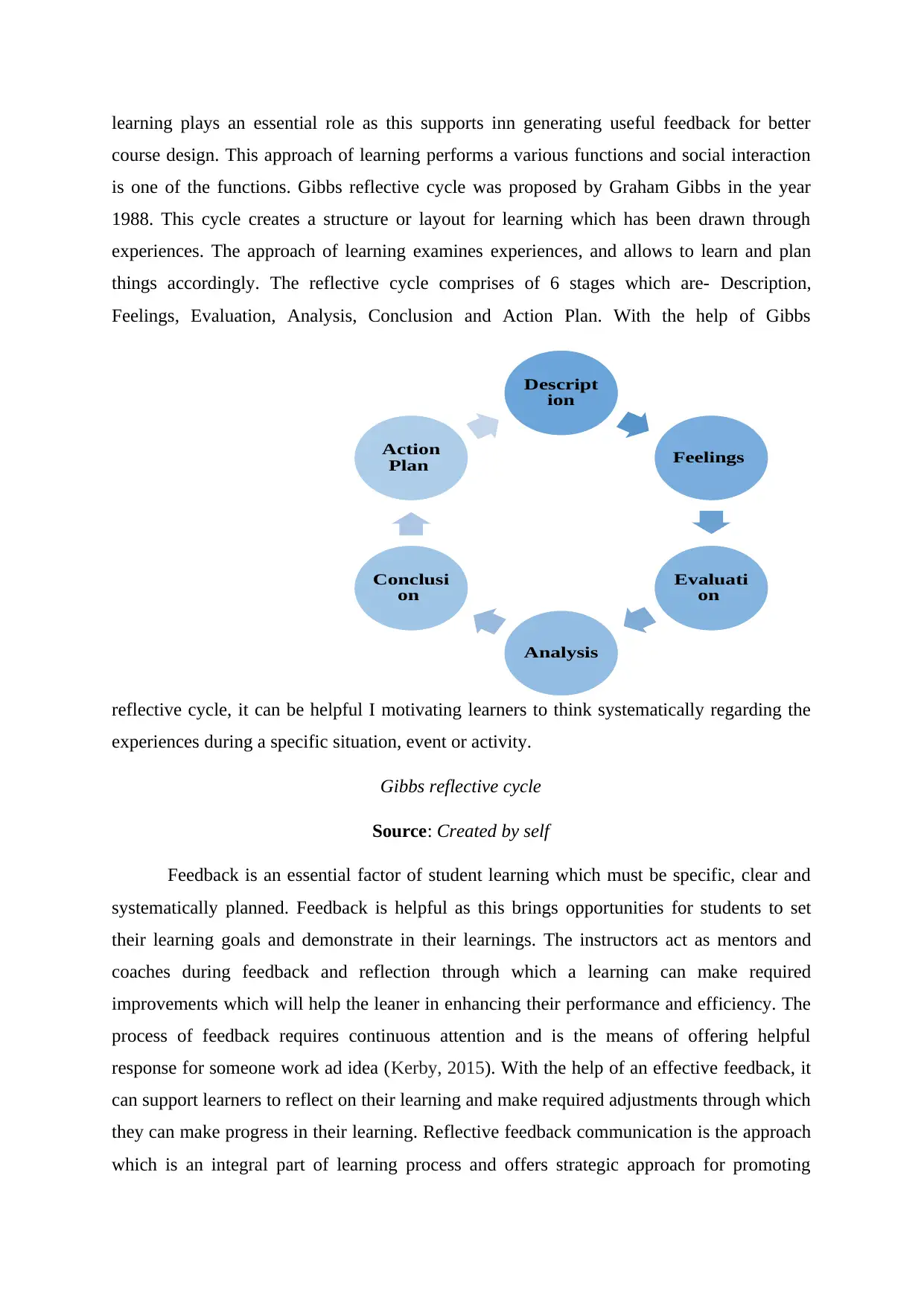
learning plays an essential role as this supports inn generating useful feedback for better
course design. This approach of learning performs a various functions and social interaction
is one of the functions. Gibbs reflective cycle was proposed by Graham Gibbs in the year
1988. This cycle creates a structure or layout for learning which has been drawn through
experiences. The approach of learning examines experiences, and allows to learn and plan
things accordingly. The reflective cycle comprises of 6 stages which are- Description,
Feelings, Evaluation, Analysis, Conclusion and Action Plan. With the help of Gibbs
reflective cycle, it can be helpful I motivating learners to think systematically regarding the
experiences during a specific situation, event or activity.
Gibbs reflective cycle
Source: Created by self
Feedback is an essential factor of student learning which must be specific, clear and
systematically planned. Feedback is helpful as this brings opportunities for students to set
their learning goals and demonstrate in their learnings. The instructors act as mentors and
coaches during feedback and reflection through which a learning can make required
improvements which will help the leaner in enhancing their performance and efficiency. The
process of feedback requires continuous attention and is the means of offering helpful
response for someone work ad idea (Kerby, 2015). With the help of an effective feedback, it
can support learners to reflect on their learning and make required adjustments through which
they can make progress in their learning. Reflective feedback communication is the approach
which is an integral part of learning process and offers strategic approach for promoting
Descript
ion
Feelings
Evaluati
on
Analysis
Conclusi
on
Action
Plan
course design. This approach of learning performs a various functions and social interaction
is one of the functions. Gibbs reflective cycle was proposed by Graham Gibbs in the year
1988. This cycle creates a structure or layout for learning which has been drawn through
experiences. The approach of learning examines experiences, and allows to learn and plan
things accordingly. The reflective cycle comprises of 6 stages which are- Description,
Feelings, Evaluation, Analysis, Conclusion and Action Plan. With the help of Gibbs
reflective cycle, it can be helpful I motivating learners to think systematically regarding the
experiences during a specific situation, event or activity.
Gibbs reflective cycle
Source: Created by self
Feedback is an essential factor of student learning which must be specific, clear and
systematically planned. Feedback is helpful as this brings opportunities for students to set
their learning goals and demonstrate in their learnings. The instructors act as mentors and
coaches during feedback and reflection through which a learning can make required
improvements which will help the leaner in enhancing their performance and efficiency. The
process of feedback requires continuous attention and is the means of offering helpful
response for someone work ad idea (Kerby, 2015). With the help of an effective feedback, it
can support learners to reflect on their learning and make required adjustments through which
they can make progress in their learning. Reflective feedback communication is the approach
which is an integral part of learning process and offers strategic approach for promoting
Descript
ion
Feelings
Evaluati
on
Analysis
Conclusi
on
Action
Plan
Paraphrase This Document
Need a fresh take? Get an instant paraphrase of this document with our AI Paraphraser
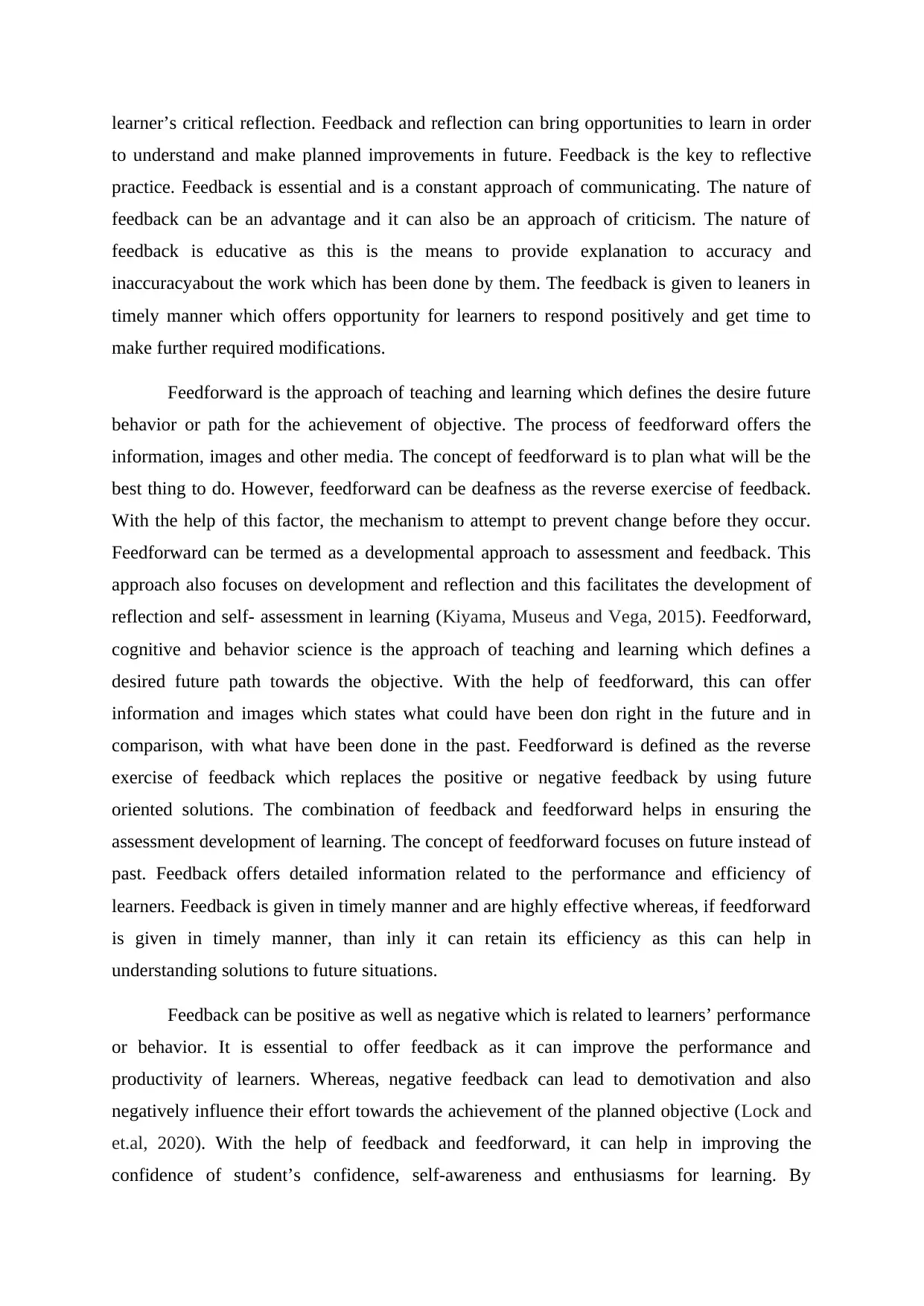
learner’s critical reflection. Feedback and reflection can bring opportunities to learn in order
to understand and make planned improvements in future. Feedback is the key to reflective
practice. Feedback is essential and is a constant approach of communicating. The nature of
feedback can be an advantage and it can also be an approach of criticism. The nature of
feedback is educative as this is the means to provide explanation to accuracy and
inaccuracyabout the work which has been done by them. The feedback is given to leaners in
timely manner which offers opportunity for learners to respond positively and get time to
make further required modifications.
Feedforward is the approach of teaching and learning which defines the desire future
behavior or path for the achievement of objective. The process of feedforward offers the
information, images and other media. The concept of feedforward is to plan what will be the
best thing to do. However, feedforward can be deafness as the reverse exercise of feedback.
With the help of this factor, the mechanism to attempt to prevent change before they occur.
Feedforward can be termed as a developmental approach to assessment and feedback. This
approach also focuses on development and reflection and this facilitates the development of
reflection and self- assessment in learning (Kiyama, Museus and Vega, 2015). Feedforward,
cognitive and behavior science is the approach of teaching and learning which defines a
desired future path towards the objective. With the help of feedforward, this can offer
information and images which states what could have been don right in the future and in
comparison, with what have been done in the past. Feedforward is defined as the reverse
exercise of feedback which replaces the positive or negative feedback by using future
oriented solutions. The combination of feedback and feedforward helps in ensuring the
assessment development of learning. The concept of feedforward focuses on future instead of
past. Feedback offers detailed information related to the performance and efficiency of
learners. Feedback is given in timely manner and are highly effective whereas, if feedforward
is given in timely manner, than inly it can retain its efficiency as this can help in
understanding solutions to future situations.
Feedback can be positive as well as negative which is related to learners’ performance
or behavior. It is essential to offer feedback as it can improve the performance and
productivity of learners. Whereas, negative feedback can lead to demotivation and also
negatively influence their effort towards the achievement of the planned objective (Lock and
et.al, 2020). With the help of feedback and feedforward, it can help in improving the
confidence of student’s confidence, self-awareness and enthusiasms for learning. By
to understand and make planned improvements in future. Feedback is the key to reflective
practice. Feedback is essential and is a constant approach of communicating. The nature of
feedback can be an advantage and it can also be an approach of criticism. The nature of
feedback is educative as this is the means to provide explanation to accuracy and
inaccuracyabout the work which has been done by them. The feedback is given to leaners in
timely manner which offers opportunity for learners to respond positively and get time to
make further required modifications.
Feedforward is the approach of teaching and learning which defines the desire future
behavior or path for the achievement of objective. The process of feedforward offers the
information, images and other media. The concept of feedforward is to plan what will be the
best thing to do. However, feedforward can be deafness as the reverse exercise of feedback.
With the help of this factor, the mechanism to attempt to prevent change before they occur.
Feedforward can be termed as a developmental approach to assessment and feedback. This
approach also focuses on development and reflection and this facilitates the development of
reflection and self- assessment in learning (Kiyama, Museus and Vega, 2015). Feedforward,
cognitive and behavior science is the approach of teaching and learning which defines a
desired future path towards the objective. With the help of feedforward, this can offer
information and images which states what could have been don right in the future and in
comparison, with what have been done in the past. Feedforward is defined as the reverse
exercise of feedback which replaces the positive or negative feedback by using future
oriented solutions. The combination of feedback and feedforward helps in ensuring the
assessment development of learning. The concept of feedforward focuses on future instead of
past. Feedback offers detailed information related to the performance and efficiency of
learners. Feedback is given in timely manner and are highly effective whereas, if feedforward
is given in timely manner, than inly it can retain its efficiency as this can help in
understanding solutions to future situations.
Feedback can be positive as well as negative which is related to learners’ performance
or behavior. It is essential to offer feedback as it can improve the performance and
productivity of learners. Whereas, negative feedback can lead to demotivation and also
negatively influence their effort towards the achievement of the planned objective (Lock and
et.al, 2020). With the help of feedback and feedforward, it can help in improving the
confidence of student’s confidence, self-awareness and enthusiasms for learning. By
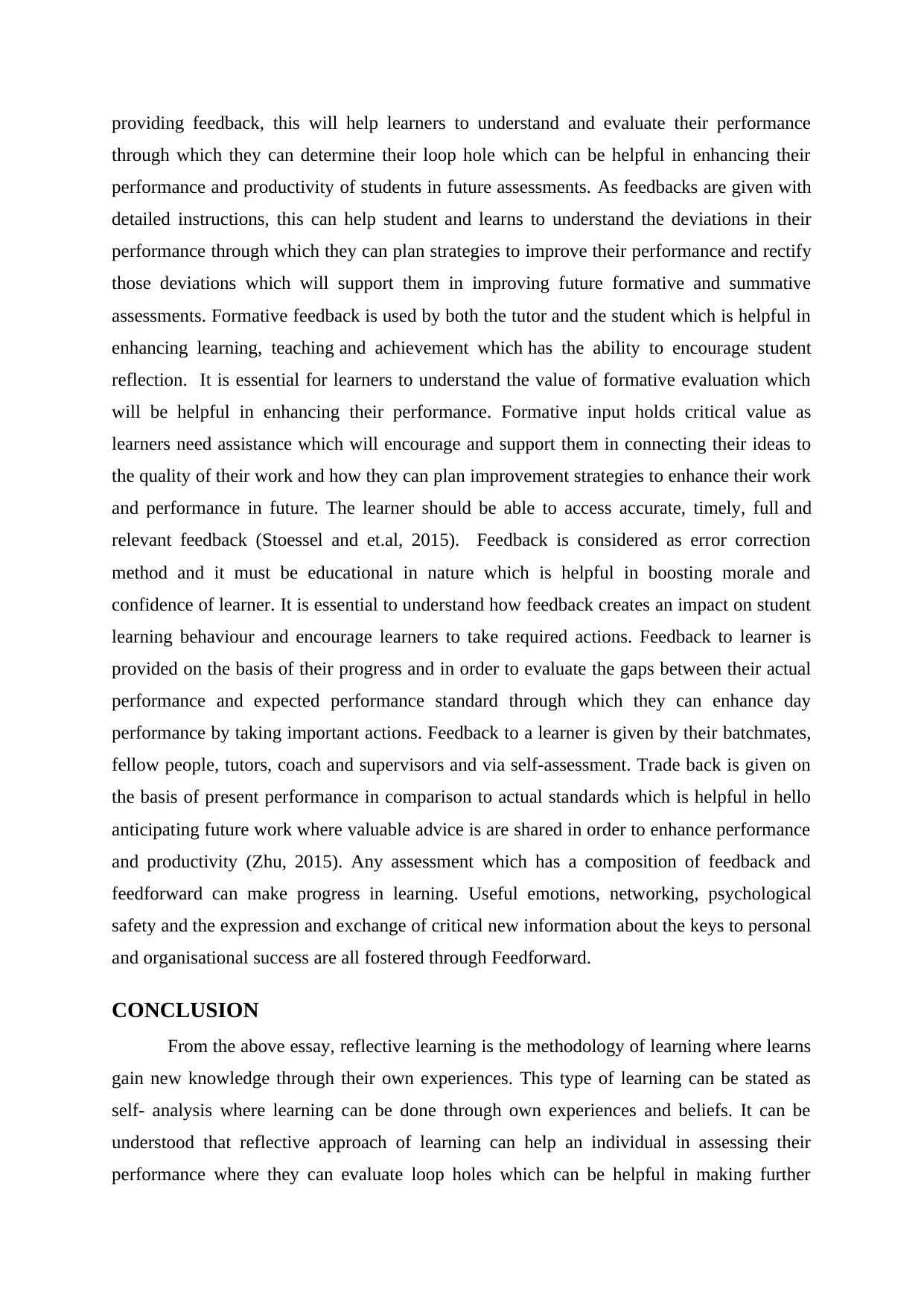
providing feedback, this will help learners to understand and evaluate their performance
through which they can determine their loop hole which can be helpful in enhancing their
performance and productivity of students in future assessments. As feedbacks are given with
detailed instructions, this can help student and learns to understand the deviations in their
performance through which they can plan strategies to improve their performance and rectify
those deviations which will support them in improving future formative and summative
assessments. Formative feedback is used by both the tutor and the student which is helpful in
enhancing learning, teaching and achievement which has the ability to encourage student
reflection. It is essential for learners to understand the value of formative evaluation which
will be helpful in enhancing their performance. Formative input holds critical value as
learners need assistance which will encourage and support them in connecting their ideas to
the quality of their work and how they can plan improvement strategies to enhance their work
and performance in future. The learner should be able to access accurate, timely, full and
relevant feedback (Stoessel and et.al, 2015). Feedback is considered as error correction
method and it must be educational in nature which is helpful in boosting morale and
confidence of learner. It is essential to understand how feedback creates an impact on student
learning behaviour and encourage learners to take required actions. Feedback to learner is
provided on the basis of their progress and in order to evaluate the gaps between their actual
performance and expected performance standard through which they can enhance day
performance by taking important actions. Feedback to a learner is given by their batchmates,
fellow people, tutors, coach and supervisors and via self-assessment. Trade back is given on
the basis of present performance in comparison to actual standards which is helpful in hello
anticipating future work where valuable advice is are shared in order to enhance performance
and productivity (Zhu, 2015). Any assessment which has a composition of feedback and
feedforward can make progress in learning. Useful emotions, networking, psychological
safety and the expression and exchange of critical new information about the keys to personal
and organisational success are all fostered through Feedforward.
CONCLUSION
From the above essay, reflective learning is the methodology of learning where learns
gain new knowledge through their own experiences. This type of learning can be stated as
self- analysis where learning can be done through own experiences and beliefs. It can be
understood that reflective approach of learning can help an individual in assessing their
performance where they can evaluate loop holes which can be helpful in making further
through which they can determine their loop hole which can be helpful in enhancing their
performance and productivity of students in future assessments. As feedbacks are given with
detailed instructions, this can help student and learns to understand the deviations in their
performance through which they can plan strategies to improve their performance and rectify
those deviations which will support them in improving future formative and summative
assessments. Formative feedback is used by both the tutor and the student which is helpful in
enhancing learning, teaching and achievement which has the ability to encourage student
reflection. It is essential for learners to understand the value of formative evaluation which
will be helpful in enhancing their performance. Formative input holds critical value as
learners need assistance which will encourage and support them in connecting their ideas to
the quality of their work and how they can plan improvement strategies to enhance their work
and performance in future. The learner should be able to access accurate, timely, full and
relevant feedback (Stoessel and et.al, 2015). Feedback is considered as error correction
method and it must be educational in nature which is helpful in boosting morale and
confidence of learner. It is essential to understand how feedback creates an impact on student
learning behaviour and encourage learners to take required actions. Feedback to learner is
provided on the basis of their progress and in order to evaluate the gaps between their actual
performance and expected performance standard through which they can enhance day
performance by taking important actions. Feedback to a learner is given by their batchmates,
fellow people, tutors, coach and supervisors and via self-assessment. Trade back is given on
the basis of present performance in comparison to actual standards which is helpful in hello
anticipating future work where valuable advice is are shared in order to enhance performance
and productivity (Zhu, 2015). Any assessment which has a composition of feedback and
feedforward can make progress in learning. Useful emotions, networking, psychological
safety and the expression and exchange of critical new information about the keys to personal
and organisational success are all fostered through Feedforward.
CONCLUSION
From the above essay, reflective learning is the methodology of learning where learns
gain new knowledge through their own experiences. This type of learning can be stated as
self- analysis where learning can be done through own experiences and beliefs. It can be
understood that reflective approach of learning can help an individual in assessing their
performance where they can evaluate loop holes which can be helpful in making further
⊘ This is a preview!⊘
Do you want full access?
Subscribe today to unlock all pages.

Trusted by 1+ million students worldwide
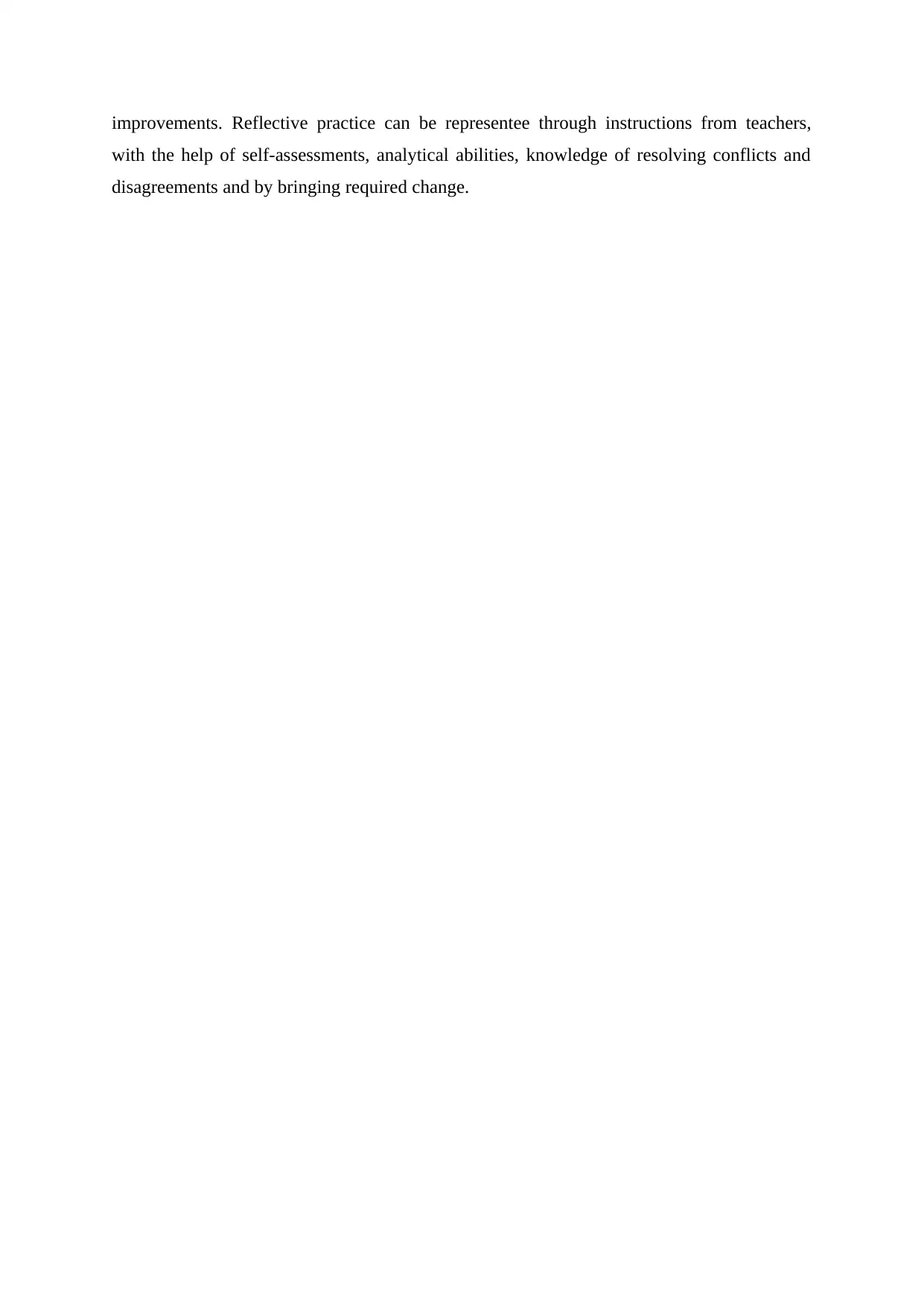
improvements. Reflective practice can be representee through instructions from teachers,
with the help of self-assessments, analytical abilities, knowledge of resolving conflicts and
disagreements and by bringing required change.
with the help of self-assessments, analytical abilities, knowledge of resolving conflicts and
disagreements and by bringing required change.
Paraphrase This Document
Need a fresh take? Get an instant paraphrase of this document with our AI Paraphraser
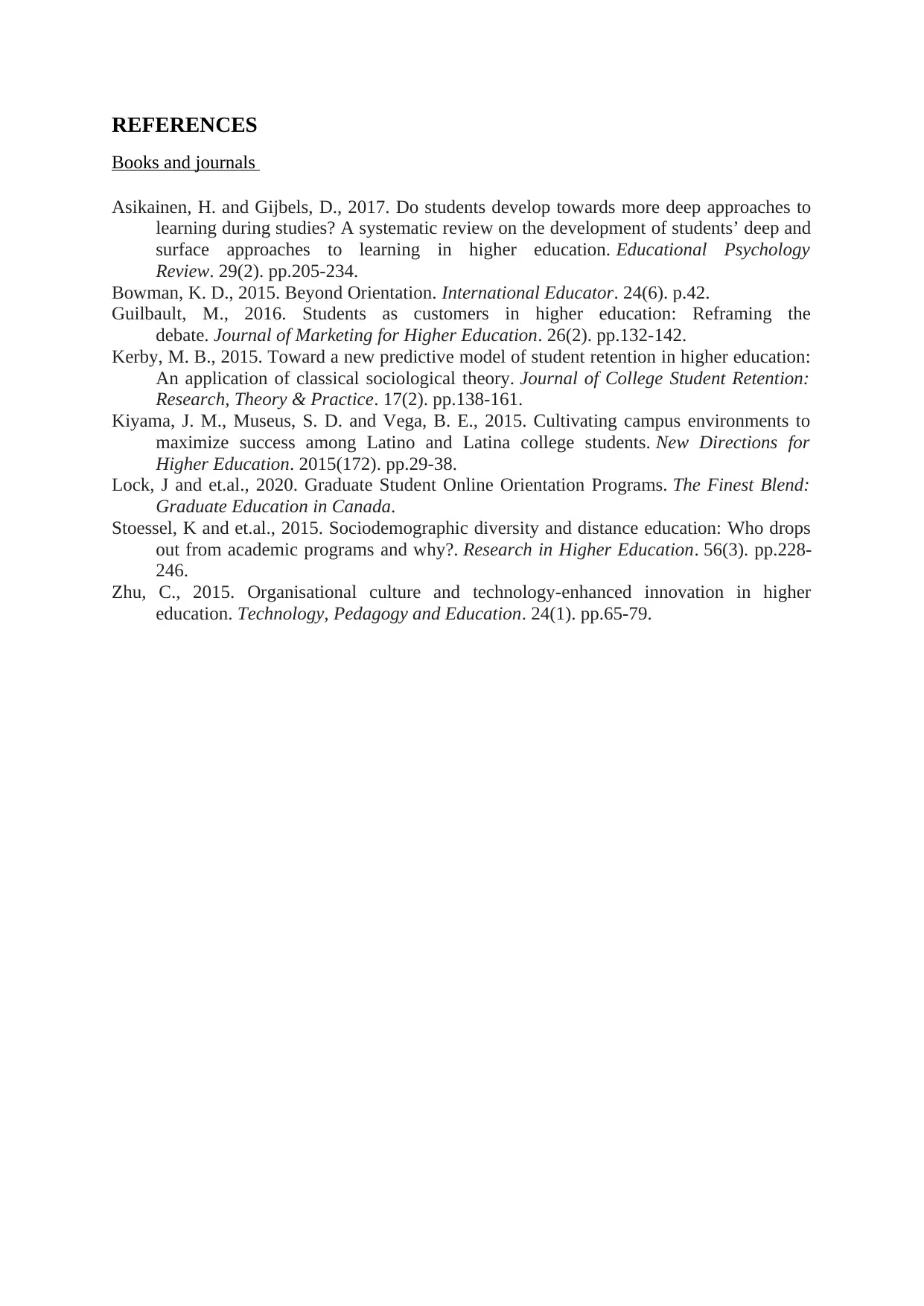
REFERENCES
Books and journals
Asikainen, H. and Gijbels, D., 2017. Do students develop towards more deep approaches to
learning during studies? A systematic review on the development of students’ deep and
surface approaches to learning in higher education. Educational Psychology
Review. 29(2). pp.205-234.
Bowman, K. D., 2015. Beyond Orientation. International Educator. 24(6). p.42.
Guilbault, M., 2016. Students as customers in higher education: Reframing the
debate. Journal of Marketing for Higher Education. 26(2). pp.132-142.
Kerby, M. B., 2015. Toward a new predictive model of student retention in higher education:
An application of classical sociological theory. Journal of College Student Retention:
Research, Theory & Practice. 17(2). pp.138-161.
Kiyama, J. M., Museus, S. D. and Vega, B. E., 2015. Cultivating campus environments to
maximize success among Latino and Latina college students. New Directions for
Higher Education. 2015(172). pp.29-38.
Lock, J and et.al., 2020. Graduate Student Online Orientation Programs. The Finest Blend:
Graduate Education in Canada.
Stoessel, K and et.al., 2015. Sociodemographic diversity and distance education: Who drops
out from academic programs and why?. Research in Higher Education. 56(3). pp.228-
246.
Zhu, C., 2015. Organisational culture and technology-enhanced innovation in higher
education. Technology, Pedagogy and Education. 24(1). pp.65-79.
Books and journals
Asikainen, H. and Gijbels, D., 2017. Do students develop towards more deep approaches to
learning during studies? A systematic review on the development of students’ deep and
surface approaches to learning in higher education. Educational Psychology
Review. 29(2). pp.205-234.
Bowman, K. D., 2015. Beyond Orientation. International Educator. 24(6). p.42.
Guilbault, M., 2016. Students as customers in higher education: Reframing the
debate. Journal of Marketing for Higher Education. 26(2). pp.132-142.
Kerby, M. B., 2015. Toward a new predictive model of student retention in higher education:
An application of classical sociological theory. Journal of College Student Retention:
Research, Theory & Practice. 17(2). pp.138-161.
Kiyama, J. M., Museus, S. D. and Vega, B. E., 2015. Cultivating campus environments to
maximize success among Latino and Latina college students. New Directions for
Higher Education. 2015(172). pp.29-38.
Lock, J and et.al., 2020. Graduate Student Online Orientation Programs. The Finest Blend:
Graduate Education in Canada.
Stoessel, K and et.al., 2015. Sociodemographic diversity and distance education: Who drops
out from academic programs and why?. Research in Higher Education. 56(3). pp.228-
246.
Zhu, C., 2015. Organisational culture and technology-enhanced innovation in higher
education. Technology, Pedagogy and Education. 24(1). pp.65-79.
1 out of 8
Related Documents
Your All-in-One AI-Powered Toolkit for Academic Success.
+13062052269
info@desklib.com
Available 24*7 on WhatsApp / Email
![[object Object]](/_next/static/media/star-bottom.7253800d.svg)
Unlock your academic potential
Copyright © 2020–2025 A2Z Services. All Rights Reserved. Developed and managed by ZUCOL.